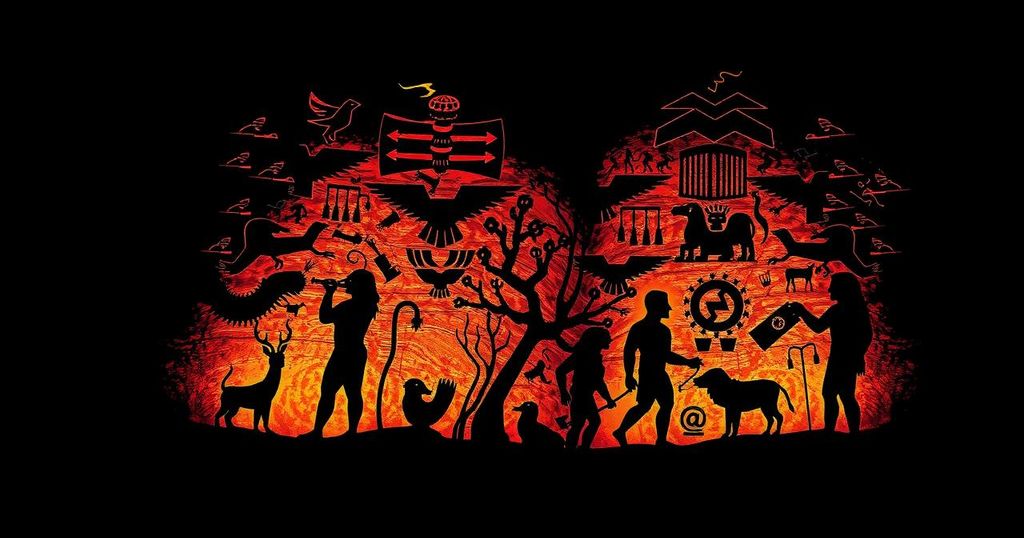Recent AI-driven research has unveiled hundreds of ancient Nazca geoglyphs in Peru, depicting unique themes like human sacrifice and domesticated animals. These smaller geoglyphs were identified through a thorough analysis of aerial images, significantly enhancing archaeological exploration in the region. The discovery emphasizes the potential of AI to expedite archaeological efforts and underscores the urgent need for conservation amidst environmental and human threats.
Recent advancements in artificial intelligence (AI) have facilitated the discovery of hundreds of ancient geoglyphs in the Peruvian desert, primarily illustrating decapitated human heads and domesticated llamas. The Nazca culture, known for carving such drawings into the earth, originated approximately 2000 years ago. These newly found geoglyphs are notably smaller and older than the famed Nazca Lines, which consist of large geometric shapes and animal figures stretching significantly across the landscape. In contrast, the newly identified images typically depict humanoids and domesticated animals, averaging around 9 meters in length. Some of these geoglyphs suggest themes of human sacrifice, including representations of killer whales wielding blades and severed heads. Dr. Masato Sakai, an academic from Yamagata University in Japan, remarked, “On some pottery from the Nazca period, there are scenes depicting orcas with knives cutting off human heads,” which indicates a cultural link between these sea creatures and human sacrifice practices within the Nazca community. The discovery of these geoglyphs was made possible through training an AI model to analyze aerial photographs of the desert plateau known as Nazca Pampa, which covered an area significantly larger than Manhattan. By generating a probability map identifying potential geoglyph locations, the AI greatly expedited the identification process, allowing researchers to confidently focus their manual inspections on the most probable sites. Research team member Marcus Freitag of IBM Research noted, “The AI helped speed up the screening process by a factor of 50, eliminating 98 percent of low-probability aerial imagery from consideration and providing probabilities for the remaining 2 percent.” Consequently, 303 geoglyphs were documented during field surveys conducted between 2022 and 2023, with 178 of these identified through AI technologies, while more were found through targeted searches within the suggested areas. Karsten Lambers from Leiden University highlighted the significance of this breakthrough, stating, “The AI-based analysis of remote sensing data is a major step forward, since a complete map of the geoglyphs of the Nazca region is still not available.” However, he also expressed caution regarding the limitations of AI in uncovering less visible geoglyphs. Future surveys await inspection of nearly 1,000 additional AI-identified candidates, primarily located on hillside terrains likely associated with individual or small group rituals. Conversely, the massive Nazca Lines likely served purposes linked to broader communal activities. The potential for discovering additional geoglyphs beyond the UNESCO World Heritage Site encompassing the Nazca Lines excites researchers, as rapid identification is paramount due to risks posed by agricultural expansion, urbanization, and wind energy projects affecting the region. David Beresford-Jones from the University of Cambridge emphasized the urgency, noting, “Many geoglyphs lie on the cusp of erasure through agricultural expansion, urban development and wind-power generation.”
The ancient Nazca geoglyphs, etched into the arid Peruvian desert, represent a significant archaeological aspect of the Nazca culture, which flourished around 2000 years ago. Traditionally, the more prominent geoglyphs, such as the Nazca Lines, have attracted attention due to their gigantic geometric and zoological designs. Recently, researchers have employed technological advances, notably artificial intelligence, to expedite the identification and analysis of lesser-known and smaller geoglyphs, which encompass various themes including ritualistic symbols and potential sacrifice. This exploration is crucial, given the ongoing threats of environmental changes and human activities that may lead to the loss of these historical artifacts.
In conclusion, the utilization of artificial intelligence has led to the remarkable discovery of numerous ancient Nazca geoglyphs in the Peruvian desert, enhancing our understanding of the cultural and spiritual practices of the Nazca civilization. The research highlights the efficiency of AI in analyzing extensive datasets and pinpointing areas of archaeological significance. Nonetheless, the preservation of these geoglyphs remains imperative, as modern developmental pressures pose significant risks to their survival. Continued field surveys and advanced technological applications are essential in safeguarding these historical treasures for future generations.
Original Source: www.newscientist.com






